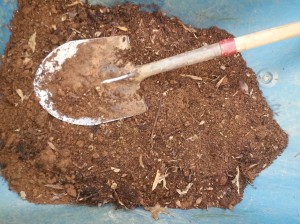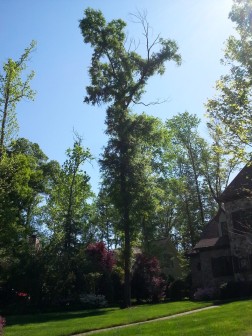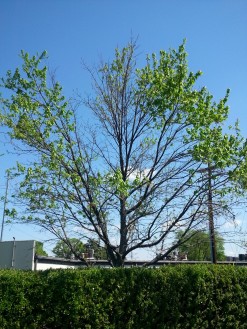As you drive along Sharon Road in Charlotte you will notice several mature Willow Oak Trees that line the road. These trees were originally planted as part of the Morrison farm and estate, back at the turn of the last century. What was once a farm is now called South Park. Yes, South Park Mall and much of its commercial and residential areas were once sprawling farmland. These trees originally lined the once country lane called Sharon Road. Shrub Doctor was recently asked to assess the health of four of these mature trees. Shrub Doctor recommended that the trees first be pruned of all dead and dying limbs. After the trees were pruned, rich organic nutrients were provided to each tree via deep root fertilization. Our mature trees are a Charlotte treasure yet they are undergoing severe stress due to drought, overcrowding, canker worms, and damages brought on by construction. Shrub Doctor has addressed this problem with its annual fertilization program, where these mature trees are supplied with rich organic nutrients each year. Shrub Doctor has ISA Certified Arborists on staff to assess the heath of your trees. Contact Shrub Doctor today to learn more about how your trees can receive our personal care and special attention so they will continue to provide you joy in the generations ahead.
Posts Tagged ‘Charlotte tree health’
Feeding Charlotte’s Giant Oaks
Posted in Around Your Neighborhood, tagged canker worms, Canker worms in Charlotte, certified arborist charlotte, Certified ISA arborist, Charlotte arborist, Charlotte tree health, Charlotte trees, Deep Root Fertilization, Myers Park Oaks, Myers Park Trees on December 7, 2016| Leave a Comment »
Jack O’Lantern Mushrooms
Posted in Around Your Neighborhood, tagged Ballentyne trees, certified arborist charlotte, Charlotte NC trees, charlotte street trees, Charlotte tree and shrub care, Charlotte tree health, Charlotte trees, Deep Root Fertilization, Myers Park Oaks, Myers Park Trees, Shrub Doctor, Tree fungus on October 4, 2016| Leave a Comment »
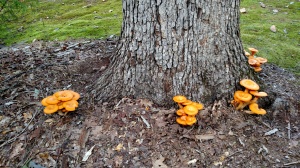 Shrub Doctor was called assess the health of this oak tree yesterday. Normally mushrooms and fungal conks growing at the base of a tree indicate advanced stages of root decay. In this case, the tree was in perfect health.
Shrub Doctor was called assess the health of this oak tree yesterday. Normally mushrooms and fungal conks growing at the base of a tree indicate advanced stages of root decay. In this case, the tree was in perfect health.
These Jack O’lantern mushrooms are actually living off of the decaying mulch and leaf debris surrounding the tree. Jack O’lantern mushrooms get their name from the strange glow that is emitted from their underbelly. Jack O’lantern mushrooms contain a substance similar to that of a lightning bug, causing the areas around the mushroom to emit a faint glow in darkness.
If you see mushrooms growing around the base of your trees, call Shrub Doctor immediately. Not all assessments of basal fungi end in good news. Our ISA Certified Arborists will provide you a clear and accurate assessment of your trees so you will have a better understanding of the health of your landscape.
Smooth Patch Fungus on Oak
Posted in Around Your Neighborhood, Organic Plant Health, Shrub care, Sustainable organic shrub care, tagged certified arborist charlotte, Certified ISA arborist, Charlotte arborist, Charlotte NC trees, Charlotte shrub care, Charlotte tree and shrub care, Charlotte tree health, Charlotte trees, Deep Root Fertilization, Diseases of shrubs, Organic shrub care Charlotte, Shrub and tree care Charlotte, Shrub Doctor, Shrub Doctor Charlotte on July 22, 2016| Leave a Comment »
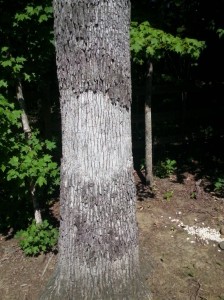 Shrub Doctor noticed a good example of smooth patch fungus activity on this tree today. Also known as white patch, this fungus decomposes the corky outer bark layer of the tree. Since the patch fungus only invades the nonliving outer bark tissues, no harm is done to the tree. Smooth patch is one of many natural occurrences that can be found in our landscapes. No treatments are needed, and your tree should recover over the future seasons. If you notice concerns with your trees and shrubs within your landscape give Shrub Doctor a call. One of our ISA Certified Arborists will be glad to schedule a visit and provide solutions that will keep your plants healthy and vigorous for many years to come.
Shrub Doctor noticed a good example of smooth patch fungus activity on this tree today. Also known as white patch, this fungus decomposes the corky outer bark layer of the tree. Since the patch fungus only invades the nonliving outer bark tissues, no harm is done to the tree. Smooth patch is one of many natural occurrences that can be found in our landscapes. No treatments are needed, and your tree should recover over the future seasons. If you notice concerns with your trees and shrubs within your landscape give Shrub Doctor a call. One of our ISA Certified Arborists will be glad to schedule a visit and provide solutions that will keep your plants healthy and vigorous for many years to come.
Regulating the Growth of a Tree
Posted in Around Your Neighborhood, tagged certified arborist charlotte, Certified ISA arborist, Charlotte arborist, Charlotte tree and shrub care, Charlotte tree health, Charlotte trees, Myers Park, Myers Park Oaks, Shrub and tree care Charlotte on May 18, 2016| Leave a Comment »
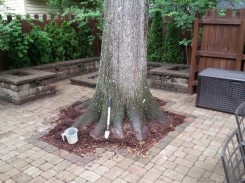
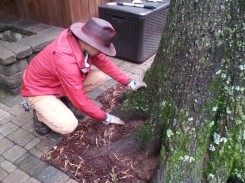
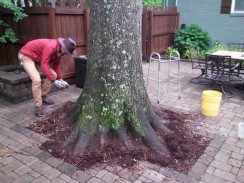
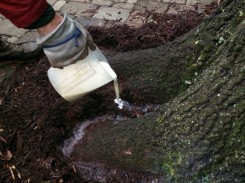
Shrub Doctor was given a unique challenge yesterday with providing a long-term sustainable solution for this Willow Oak tree. The tree has no space to grow in this backyard patio area. Shrub Doctor’s solution was a tree growth regulation treatment. This treatment reduces the growth of the tree’s canopy and redirects its energy towards the production of a more fibrous root system. More fine roots mean more nutrient uptake, and a more efficient ability to absorb moisture. With its limited area for both, this tree needs all the help it can get. If you have a tree in a restricted area give Shrub Doctor a call. Our certified arborists will evaluate your tree and provide you with a long-term solution that provides a more sustainable future for your tree and landscape.
Treating Tea Scale on Giant Camellia Shrubs
Posted in Organic Plant Health, tagged Ballentyne trees, certified arborist charlotte, Charlotte NC trees, Charlotte shrub care, Charlotte tree health, Diseases of shrubs, Organic shrub care Charlotte on February 24, 2016| Leave a Comment »


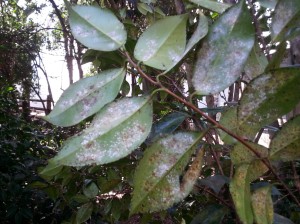 We took the opportunity the other day to treat a grove of huge camellia shrubs that were infested with scale insect activity. Shrub Doctor has had great success killing scale infestations with horticultural oil and our backpack fogging machine. We blast the oil into the canopy of the shrubs suffocating the scale. We have used this non-toxic method to control scale activity with our customers for many years. If you have a scale insect problem, call Shrub Doctor at 704-920-0290. We will promptly visit your landscape and get your landscape back in control.
We took the opportunity the other day to treat a grove of huge camellia shrubs that were infested with scale insect activity. Shrub Doctor has had great success killing scale infestations with horticultural oil and our backpack fogging machine. We blast the oil into the canopy of the shrubs suffocating the scale. We have used this non-toxic method to control scale activity with our customers for many years. If you have a scale insect problem, call Shrub Doctor at 704-920-0290. We will promptly visit your landscape and get your landscape back in control.
Transplanting Dogwood Trees
Posted in Around Your Neighborhood, tagged Ballentyne trees, Certified ISA arborist, Charlotte arborist, Charlotte NC trees, Charlotte shrub care, charlotte street trees, Charlotte tree and shrub care, Charlotte tree health, Charlotte trees, Deep Root Fertilization, Myers Park Oaks, Myers Park Trees on February 11, 2016| Leave a Comment »
The late winter season is a great time to transplant your dogwood trees. Shrub Doctor moved this tree just the other day. We made a sequence of photos to record the proper procedures that we use to assure a successful transplant. The first photo shows where we severed the roots for easy removal. We next found some great organic compost right under a willow oak, at the back of the property. This compost was mixed with the clay soil removed from the new tree site. Note how we added a few rotting limbs to the bottom of the hole to help improve the fungi populations in the soil. You can find earlier posts that describe this procedure in more detail. We next fertilized the tree with our special blend of poultry manure and completed the planting with a slow deep soaking of the tree. We will continue to perform this same watering procedure about three times a week until we feel the tree can make it on its own. If you have any questions about transplanting your trees or shrubs give Shrub Doctor a call at 704-920-0290. We’ll be glad to give you advise to assure that you too have a successful day in your garden.
Organic Compost in Your Landscape
Posted in Around Your Neighborhood, tagged Ballentyne trees, Boxwood care Charlotte, Charlotte shrub care, Charlotte tree and shrub care, Charlotte tree health, Charlotte trees on December 21, 2015| Leave a Comment »
Many of our customers don’t realize they have rich organic compost right on their property. Shrub Doctor always recommends planting shrubs with a 50/50 blend of clay soil from the planting hole with good organic matter. Most customers run to the home improvement store and purchase expensive bagged compost for their planting projects. Shrub Doctor recently went to the wooded area of a customer’s landscape and retrieved a full wheel barrow load of super rich compost. The customer had no idea it was there. If you have a wooded area on your property, brush back the leaves and harvest the decaying matter below them. You will usually have about an inch of rich organic soil right at your fingertips. Brush the leaves back over the area and return next year for another harvest of compost. Call Shrub Doctor today for more tips about a healthier landscape, and ask us more about how our 100% organic shrub and tree fertilization programs for your shrubs and ornamental trees. Call 1-888-2GO-Organic today. (1-888-246-6742).
White Oak -Trunk Damage
Posted in Around Your Neighborhood, tagged Ballentyne trees, certified arborist charlotte, Certified ISA arborist, Charlotte arborist, Charlotte NC trees, Charlotte shrub care, Charlotte tree and shrub care, Charlotte tree health, Charlotte trees, Deep Root Fertilization on May 6, 2015| Leave a Comment »
Shrub Doctor was called to assess and treat this white oak tree. It appears that a tree service has removed several lower limbs in the past years yet did not properly cut the limbs back to the collar of the tree trunk. Over the years minor rotting has occurred underneath the remaining limb of the tree. Shrub Doctor stripped away the bark, removed the decayed wood, and killed the existing populations of insects that were harbored in the wound area. After cleaning the wounded area, an orange rind oil was applied to the wound to minimize future decay. The orange oil will soak into the wound and reduce further insect activity. During future seasons the tree will slowly close this wound. Shrub Doctor will monitor the healing process and keep the customer informed with its progress.
Decline of Oak Tree
Posted in Around Your Neighborhood, tagged Ballentyne trees, certified arborist charlotte, Certified ISA arborist, Charlotte arborist, Charlotte NC trees, Charlotte shrub care, charlotte street trees, Charlotte tree and shrub care, Charlotte tree health, Charlotte trees, Deep Root Fertilization on April 23, 2015| Leave a Comment »
Here’s an example of an oak tree that is experiencing serious stress due to its new urban environment. You will notice the small sprouting branches along its trunk, and the dead limbs in its crown. Not many years ago this tree was thriving in the forest. Urban development cleared away the other trees and left this one in the landscape. This tree has survived the removal of its organic top soil, heavy grading and change of topography, and the construction of this house. The tree now experiences competition with the turf, compacted soil, and a serious reduction of organic nutrition.
Shrub Doctor is regularly contacted to help trees in this state of stress. Our certified arborists will assess the health of the tree, recommend removal of limbs and dead wood from the crown, and treat the tree with our organic nutrients to restore its health and promote root growth. Shrub Doctor has over ten years experience restoring the health of Charlotte’s prized trees. Call Shrub Doctor today for a free evaluation of your tree’s health. Contact us at 704-490-2000. Our doctors still make house calls.
Long-Term Affects of Gloomy Scale Activity
Posted in Around Your Neighborhood, tagged Ballentyne trees, certified arborist charlotte, Certified ISA arborist, Charlotte arborist, Charlotte NC trees, charlotte street trees, Charlotte tree and shrub care, Charlotte tree health, Charlotte trees, Deep Root Fertilization on April 21, 2015| Leave a Comment »
I have been watching this maple tree outside our office warehouse lately. Notice how there is no foliage emerging within its canopy. Only the tips of the limbs have leaves. In a previous post I showed photos of its bark and the multiple layers of bark scale insects that are feeding on the sap of the tree. Underneath these small bumps is a scale insect that is continually feeding on the sap of the tree. Overtime these insects multiply until they so overwhelm the tree that foliage cannot emerge from the limbs. The scale insects slowly migrate up into the canopy of the tree. This tree is experiencing the advanced stages of a scale insect infestation. Sadly, many urban maple trees around the city of Charlotte are infested with bark scale. Shrub Doctor often notices that many dense neighborhoods with heavily planted maple trees have this condition. If left untreated, this photo will be the result. Shrub Doctor has performed many bark scale treatments this season. We can save your trees from gloomy scale. Give us a call today to learn more about this problem and how Shrub Doctor can save your trees. Shrub Doctor Inc. has ISA Certified Arborists on staff to evaluate the health of your trees. Give us a call today at 704-920-0290.










